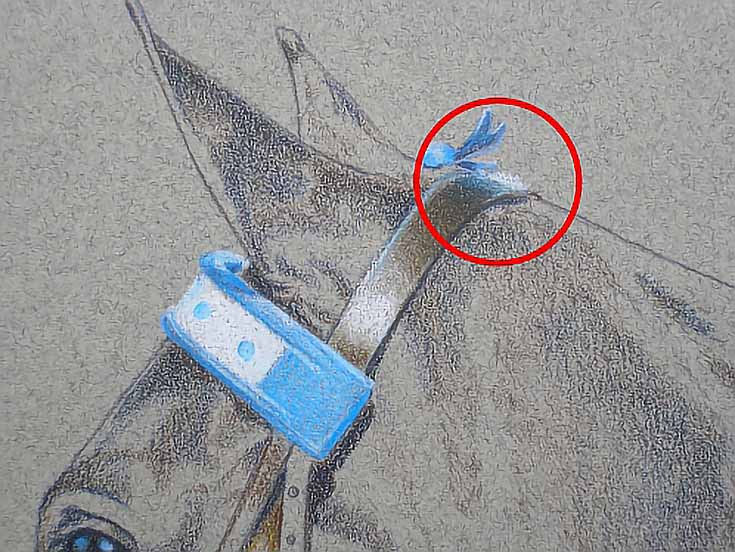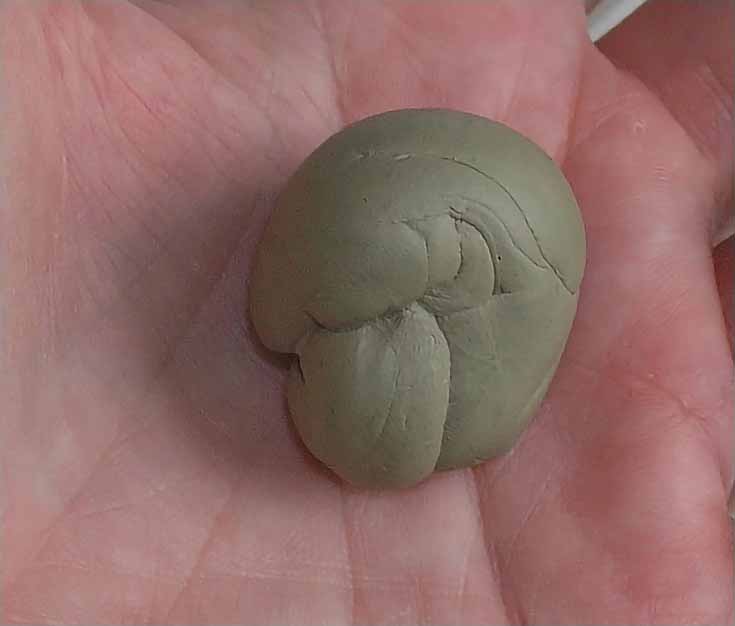You’ve worked on a complicated, vignette-style drawing for hours. You’re almost finished when you notice a stray mark on the background. What’s worse, the mark is too close to the subject to just crop it out.
You’re heart drops into your stomach. All that work, and the drawing is ruined.
Or is it?
This exact situation happened to me just a few days ago. I was in the middle of teaching an email drawing class, so I couldn’t scrap the drawing. It had to be fixed. The good news is that I found a way to hide the stray mark.
Even better—the methods I used will work for you, too. Take a look.
The problem
Here’s the mistake I made (inside the red circle). I drew the reflected light with a pencil that wasn’t sharp enough, accidentally extendeding it beyond the edge of the strap.
SIDE NOTE: When working on small pieces or on small areas within large pieces, it’s doubly important to keep your pencils sharp. Otherwise, you’ll be going back and cleaning up mistakes like this one.
How to fix it: Step 1—Lift the color
First of all, take a deep breath and relax.
Then lift as much of the stray mark as you can by carefully stroking it with an eraser. Stroke along the length of the mark, not across it to avoid moving color onto clean paper. The best method is to use sticky stuff (Poster-Tack, Blu-Tack, etc.) or a kneaded eraser.
Press that against the mark, then gently lift it. Rotate the sticky stuff (or clean it) so you’re using a fresh surface each time. Repeat until no more color comes off on the sticky stuff.
Other types of erasers designed for colored pencil work are also useful tools in this situation, but I’ve had the best results with sticky stuff.
Transparent tape may also work, but is not recommended. If transparent tape is all you have, tear off a small piece, then lay it over the stray mark. Press it gently against the paper by rubbing a finger tip across it, then very carefully lift the tape. You can repeat the process with a clean piece of tape if you like, but I don’t usually recommend more than two applications because of the risk of damaging the paper.
TIP: To reduce the stickiness of the tape, press it against your pantleg or other lint-free material first. For more information, read 2 Neat Tricks for“Lifting” Color from Colored Pencil Drawings.
How to fix it: Step 2—Covering the mark
My mistake was too close to the edges of my drawing to try erasing it, so I had to jump straight to this step. I turned over my paper and began testing various different gray pencils, looking for one that was the same color as the medium gray paper I was using.
Some were too light, some were too dark, but I was able to find one that was an almost exact match!
I sharpened that pencil to as sharp a point as I could and stroked very carefully along the outside edge of the drawing, as shown here.
If your mistake is similar to mine, use the same method. If it’s a random mark, from dropping a pencil on the paper, for example, stroke along the length of the mark.
Either way, start with light pressure for the first stroke. That may be all that’s required to cover the stray mark. If not, stroke a couple of more times, or increase pressure slightly until the mark is covered. Turn your pencil slightly after each stroke to keep the sharpest point possible on the paper.
As it turned out, a couple of strokes applied with light-ish pressure helped immensely.
Once the mark was covered, I fine-tuned the inside edge of the leather strap by re-enforcing the reflected light with a stroke or two of Cool Grey 20% and adding a form shadow on the back edge of the strap with Indigo Blue.
The whole thing took five minutes and the problem was solved!
What if you can’t match the color of your paper?
If you can’t find an exact match between pencil and paper, use two or more colors and the layering method to blend a good match. Do as many test swatches as necessary to find the right combination. Make sure to consider the color of the pencil you were using when you made the stray mark, because it will affect any colors layered over it.
TIP: The final color will also be affected by the order in which you apply each of the colors you’re blending, so don’t forget to try them in different orders when you’re making test swatches, and then remember that order as you cover over the mark.
Using light pressure and sharp pencils is especially important here.
As a last resort. . .
If nothing else works, you can always add some additional color in accent areas around the drawing. If you do this, shade lightly with the color of the stray mark, then add whatever other colors are appropriate over that.
But wait until the drawing is finished, then add colors that will support the entire drawing.
You could also convert your vignette-style drawing into a drawing with a full background. I’ve had to do this a time or two, and have had good success.
Whatever method you use, the point is that a stray mark need not be the end of your drawing. . . there’s almost always a way to correct it, with a little creativity and patience!
This post may contain affiliate links.




